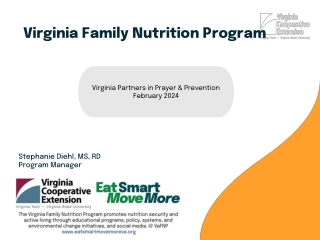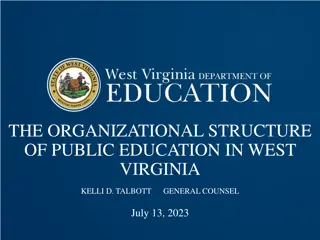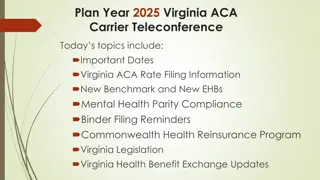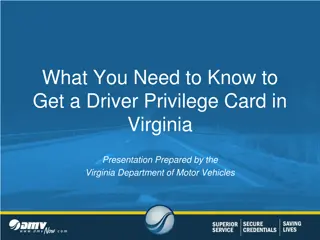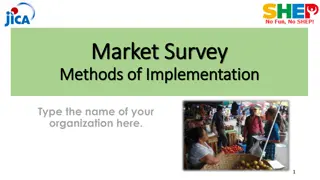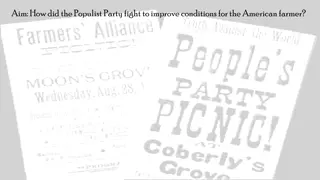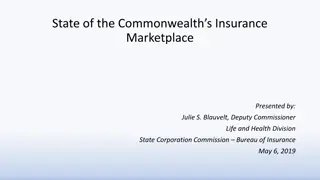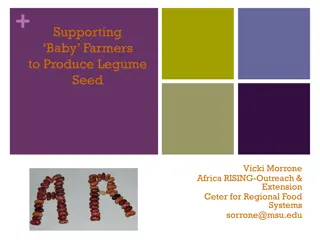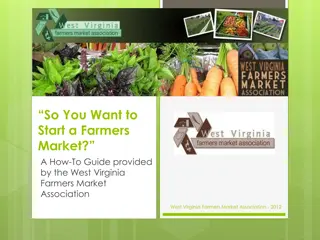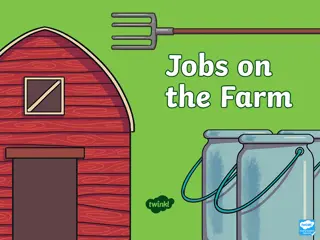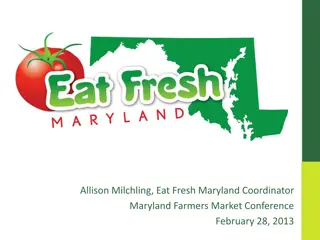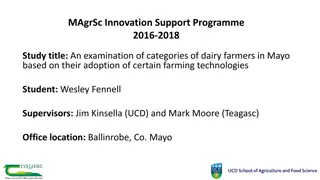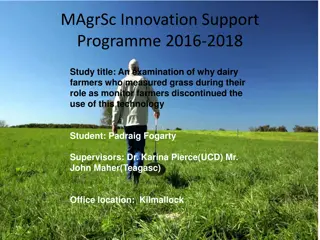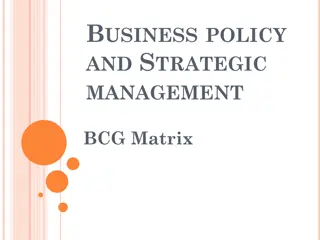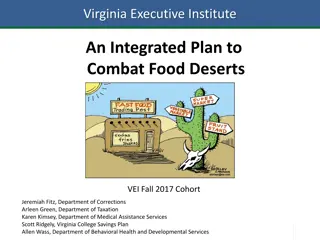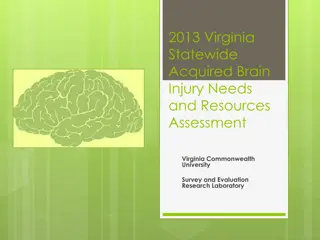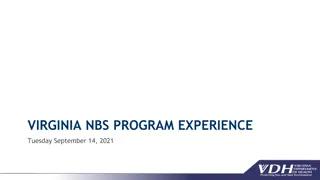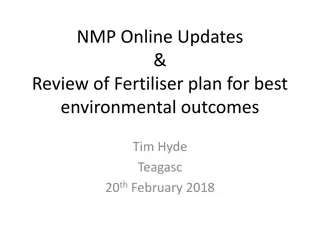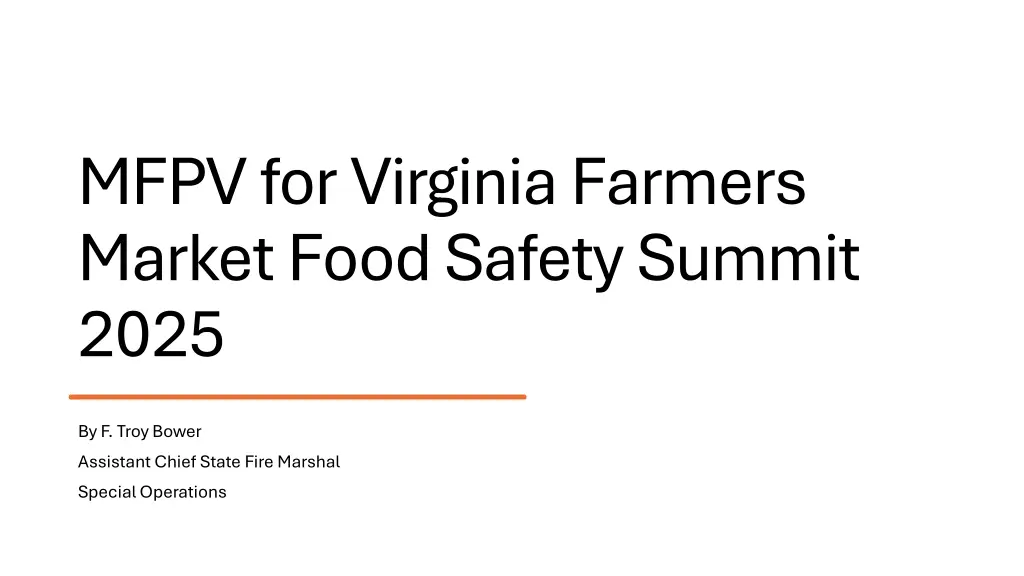
Understanding Mobile Food Preparation Vehicles in Virginia
Learn about Mobile Food Preparation Vehicles (MFPVs) in Virginia, their definition, regulations, and the authority having jurisdiction. Discover the safety aspects, permit requirements, and scenarios regarding MFPVs in the state.
Download Presentation

Please find below an Image/Link to download the presentation.
The content on the website is provided AS IS for your information and personal use only. It may not be sold, licensed, or shared on other websites without obtaining consent from the author. If you encounter any issues during the download, it is possible that the publisher has removed the file from their server.
You are allowed to download the files provided on this website for personal or commercial use, subject to the condition that they are used lawfully. All files are the property of their respective owners.
The content on the website is provided AS IS for your information and personal use only. It may not be sold, licensed, or shared on other websites without obtaining consent from the author.
E N D
Presentation Transcript
MFPV for Virginia Farmers Market Food Safety Summit 2025 By F. Troy Bower Assistant Chief State Fire Marshal Special Operations
Mobile Food Preparation Vehicles:
What Exactly is an MFPV?
VSFPC Definition of MFPVs: Vehicles, covered trailers, carts, and enclosed trailers, or other moveable devices capable of being able to be occupied by persons during cooking operations and that contain cooking equipment that utilize open flames or are capable of producing smoke or grease laden vapors for the purpose of preparing and serving food to the public. Vehicles used for private recreation shall not be considered mobile food preparation vehicles. What Exactly is an MFPV? Containing Equipment that EITHER Utilizes Open Flames OR Produces Grease Laden Vapor AND Capable of Being Occupied AND SERVES Food to the Public.
Operating MFPVs is a permittable operation with inherent risks of fire and explosion. Section 319 is a Virginia Amendment that was introduced to meet a recognized safety need in the Commonwealth.
MFPVs Who is the AHJ? 319.2.1 Permit authority having jurisdiction (AHJ). The enforcing agent of a permit requirement on a mobile food preparation vehicle (MFPV) shall be the appointed fire official for the Virginia local governmentto which the food truck is identified for personal property tax payment of the vehicle. If no such entity exists, if the local governmenthas elected to not enforce this section of the SFPC, or if the MFPV is housed out of state, then it shall be the State Fire Marshal s Office (SFMO) or designee.
MFPVs Who is the AHJ? Scenario: Scenario: MFPV is registered in a locality (town, city, or county) who BOTH has a local Fire Official AND has elected to enforce the provisions of Section 319 of the VSFPC Authority Having Jurisdiction: Authority Having Jurisdiction: Fire Official for the locality in which the MFPV is registered for the payment of personal property taxes. (This can be found on the vehicle title, under the section labeled: "Garaged In:") The Virginia State Fire Marshal's Office (or designee), via the issuance and approval of an MOU between the local Fire Official and the State Fire Marshal's Office The Virginia State Fire Marshal's Office (or designee) MFPV is registered in a locality (town, city, or county) who has a local Fire Official, however, the locality has opted NOT to enforce the provisions of Section 319 of the VSFPC MFPV is registered in a locality (town, city, or county) that does not have an appointed Fire Official. MFPV is HOUSED in a locality outside of the Commonwealth of Virginia. The Virginia State Fire Marshal's Office (or designee)
MFPVs Who is the AHJ? VSFPC, 319.2.1does NOT offer an option to leave MFPV's uninspected.I.E., No turning a blind eye. (Even if you love tacos al pastor as much as I do.) The only options available arelocalenforcement, or enforcement by the State Fire Marshal's Office or designee.
Permitted or Not?? We may still do a MFPV Inspection EVEN if it has been permitted by another AHJ. There will be no charge for this inspection and no permit issued.
319.1 General. 319.1 General. Mobile food preparation vehicles that are equipped with appliances that utilize open flames or produce smoke or grease laden vapors shall comply with this section. 319.1.1 Wheel chocks. 319.1.1 Wheel chocks. Wheel chocks shall be used to prevent mobile food preparation vehicles from moving. VIRGINIA STATEWIDE FIRE PREVENTION CODE 31 GENERAL REQUIREMENTS 319.1.2 Separation. 319.1.2 Separation. Mobile food preparation vehicles shall be separated from buildings or structures, combustible materials, vehicles, and other cooking operations by a minimum of 10 ft. (3m). 2021 VSFPC MFPV Regulations
319.2 Permit required. 319.2 Permit required. Permits shall be required as set forth in Section 107.2. 319.2.1 Permit authority having 319.2.1 Permit authority having jurisdiction (AHJ). jurisdiction (AHJ). The enforcing agent of a permit requirement on a mobile food preparation vehicle (MFPV) shall be the appointed fire official for the Virginia local government to which the food truck is identified for personal property tax payment of the vehicle. If no such entity exists, if the local government has elected to not enforce this section of the SFPC, or if the MFPV is housed out of state, then it shall be the State Fire Marshal's Office (SFMO) or designee. 2021 VSFPC MFPV Regulations
2021 VSFPC MFPV Regulations 319.3 Seating. 319.3 Seating. Seating for the public within any mobile food preparation vehicles is prohibited.
2021 VSFPC MFPV Regulations 319.4 Exhaust hood. 319.4 Exhaust hood. Cooking equipment that produces grease laden vapors shall be provided with a kitchen exhaust hood in accordance with NFPA 96, Annex B.
319.5 Fire protection. 319.5 Fire protection. Fire protection shall be provided in accordance with Sections 319.5.1 through 319.5.2. 319.5.1 Fire protection for cooking 319.5.1 Fire protection for cooking equipment. equipment. Cooking equipment shall be protected by automatic fire extinguishing systems in accordance with Section 904.3.1. 319.5.2 Fire extinguisher. 319.5.2 Fire extinguisher. Portable fire extinguishers shall be provided in accordance with Section 906.4. 2021 VSFPC MFPV Regulations
319.6 Appliance connection to fuel 319.6 Appliance connection to fuel supply. supply. Gas cooking appliances shall be secured in place and connected to fuel supply piping with an appliance connector complying with ANSI Z21.69/CSA 6.16. The connector installation shall be configured in accordance with manufacturer's installation instructions. Movement of appliances shall be limited by restraining devices installed in accordance with the connector and appliance manufacturer's instructions. 2021 VSFPC MFPV Regulations
319.6.1 Construction and modifications. 319.6.1 Construction and modifications. Following initial construction and any modifications of the fuel system, the system, including hoses, shall be proven free of leaks by performing a pressure test in accordance with NFPA 58 at not less than the normal operating pressure. 319.6.2 Leak detection. 319.6.2 Leak detection. Gas systems shall be inspected prior to each use and following fuel tank replacement or refill in one of the following methods: 1. A water and soap solution shall be applied to every accessible connection or connection manipulated during the replacement or fueling and observed for evidence of gas leakage. 2. 2. Pressure testing in accordance with Annex L of NFPA 58. 3. 3. 319.6.3 Leaks. 319.6.3 Leaks. When leaks are discovered during inspections and testing, the fuel supply shall be secured in the "off" position or disconnected from the appliance, and the appliance shall not be operated until serviced by a qualified person. 2021 VSFPC MFPV Regulations
319.7 Cooking oil storage containers. 319.7 Cooking oil storage containers. Cooking oil storage containers within mobile food preparation vehicles shall have a minimum aggregate area volume not to exceed 120 gallons (454 L) and shall be stored in such a way as to not be toppled or damaged during transport. 2021 VSFPC MFPV Regulations
319.8 Cooking oil storage tanks. 319.8 Cooking oil storage tanks. Cooking oil storage tanks within mobile food preparation vehicles shall comply with Sections 319.8.1 through 319.8.5. 319.8.1 Metallic storage tanks 319.8.1 Metallic storage tanks. Metallic cooking oil storage tanks shall be listed in accordance with UL 142 or UL 80,and shall be installed in accordance with the tank manufacturer's instructions. 319.8.2 Nonmetallic tanks 319.8.2 Nonmetallic tanks. Nonmetallic cooking oil storage tanks shall be installed in accordance with the tank manufacturer's instructions and shall also comply with all of the following: 1. Tanks shall be listed for use with cooking oil, including maximum temperature to which the tanks will be exposed to during use. 2. 2. Tank capacity shall not exceed 200 gallons (757 L) per tank. VIRGINIA STATEWIDE FIRE PREVENTION CODE 32 GENERAL REQUIREMENTS 319.8.3 Cooking oil storage system components. 319.8.3 Cooking oil storage system components. Metallic and nonmetallic cooking oil storage system components shall include piping, connections, fittings, valves, tubing, hose, pumps, vents, and other related components used for the transfer of cooking oil. 2021 VSFPC MFPV Regulations
319.8.4 Design criteria. 319.8.4 Design criteria. The design, fabrication, and assembly of system components shall be suitable for the working pressures, temperatures, and structural stresses to be encountered by the components. 319.8.5 Tank venting. 319.8.5 Tank venting. Normal and emergency venting shall be provided for cooking oil storage tanks. 319.8.5.1 Normal vents. 319.8.5.1 Normal vents. Normal vents shall be located above the maximum normal liquid line and shall have a minimum effective area not smaller than the largest filling or withdrawal connection. Normal vents are not required to vent to the exterior. 319.8.5.2 Emergency vents. 319.8.5.2 Emergency vents. Emergency relief vents shall be located above the maximum normal liquid line and shall be in the form of a device that will relieve excessive internal pressure caused by an exposure fire. For nonmetallic tanks, the emergency relief vent shall be allowed to be in the form of construction. Emergency vents are not required to discharge to the exterior. 2021 VSFPC MFPV Regulations
319.9 Liquefied petroleum gas (LP 319.9 Liquefied petroleum gas (LP- -gas) systems. gas systems provide fuel for cooking appliances, such systems shall comply with NFPA 58, Chapter 61, and Sections 319.9.1 through 319.9.5. 319.9.1 Maximum aggregate volume. 319.9.1 Maximum aggregate volume. The maximum aggregate capacity of LP-gas containers transported on the vehicle and used to fuel cooking appliances only shall not exceed 200 pounds propane capacity. 319.9.2 Protection of container. 319.9.2 Protection of container. LP-gas containers installed on the vehicle shall be securely mounted and restrained to prevent movement. 319.9.3 LP 319.9.3 LP- -gas container construction. gas container construction. LP-gas containers shall be manufactured in compliance with the requirements of NPFA 58. 319.9.4 Protection of system piping. 319.9.4 Protection of system piping. LP-gas system piping, including valves and fittings, shall be adequately protected to prevent tampering, impact damage, and damage from vibration. 319.9.5 LP 319.9.5 LP- -gas alarms gas alarms. A listed LP-gas alarm shall be installed with the vehicle in the vicinity of LP-gas system components, in accordance with manufacturer's instructions. gas) systems. Where LP- 2021 VSFPC MFPV Regulations
319.10 Compressed natural gas (CNG) systems. 319.10 Compressed natural gas (CNG) systems. Where CNG systems provide fuel for cooking appliances, such systems shall comply with Sections 319.10.1 through 319.10.4. 319.10.1 CNG containers supplying only cooking 319.10.1 CNG containers supplying only cooking fuel. fuel. CNG containers installed solely to provide fuel for cooking purposes shall be in accordance with Sections 319.10.1.1 through 319.10.1.3. 319.10.1.1 Maximum aggregate volume. 319.10.1.1 Maximum aggregate volume. The maximum aggregate capacity of CNG containers transported on the vehicle shall not exceed 1,300 pounds water capacity. 319.10.1.2 Protection of container. 319.10.1.2 Protection of container. CNG containers shall be securely mounted and restrained to prevent movement. Containers shall not be installed in locations subject to direct vehicle impact. 319.10.1.3 CNG container construction. 319.10.1.3 CNG container construction. The construction of CNG containers shall be approved. 2021 VSFPC MFPV Regulations
319.10.2 CNG containers supplying 319.10.2 CNG containers supplying transportation and cooking fuel. transportation and cooking fuel. Where CNG containers and systems are used to supply fuel for cooking purposes in addition to being used for transportation fuel, the installation shall be in accordance with NFPA 52. 319.10.3 Protection of system piping. 319.10.3 Protection of system piping. CNG system piping, including valves and fittings, shall be adequately protected to prevent tampering, impact damage, and damage from vibration. 319.10.4 Methane alarms. 319.10.4 Methane alarms. A listed methane gas alarm shall be installed within the vehicle in accordance with manufacturer's instructions. 2021 VSFPC MFPV Regulations
319.11 Maintenance. 319.11 Maintenance. Maintenance of systems on mobile food preparation vehicles shall be in accordance with Sections 319.11.1 through 319.11.3. 319.11.1 Exhaust system. 319.11.1 Exhaust system. The exhaust system, including hood, grease-removal devices, fans, ducts and other appurtenances, shall be inspected and cleaned in accordance with Chapter 6. 319.11.2 Fire protection systems and 319.11.2 Fire protection systems and devices. devices. Fire protection systems and devices shall be maintained in accordance with Chapter 9. 2021 VSFPC MFPV Regulations
319.11.3 Fuel 319.11.3 Fuel- -gas systems. installed on the vehicle and fuel-gas piping systems shall be inspected annually by an approved inspection agency or a company that is registered with the U.S. Department of Transportation to requalify LP-gas cylinders to ensure that system components are free of damage, suitable for the intended service, and not subject to leaking. CNG containers shall be inspected every three years in a qualified service facility. CNG containers shall not be used past their expiration dates listed on the manufacturer's container label. Upon satisfactory inspection, the approved inspection agency shall affix a tag on the fuel- gas system or within the vehicle indicating the name of the inspection agency and the date of satisfactory inspection. gas systems. LP-gas containers 2021 VSFPC MFPV Regulations
www.vafire.com Website:
- Under PROGRAMS AND PERMITS PROGRAMS AND PERMITS State Fire Marshal s Office - Mobile Food Preparation Vehicles - MFPV Checklist -contains most of SFPV Chapter 319 - MFPV Contract
Website is being updated as we speak: -Should go live by the end of 2025 Website info: -Will be able to do everything online (laptop or mobile device), including make a payment.
F. Troy Bower, CFO, CFPI Assistant Chief State Fire Marshal Special Operations Virginia State Fire Marshal's Office 1005 Technology Park Drive Glen Allen, VA 23059 Contact info: troy.bower@vdfp.virginia.gov www.vafire.com

